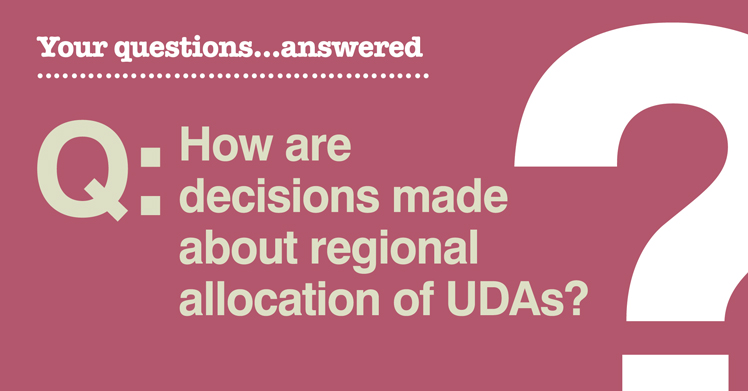The details of government and public bodies’ machinations are often convoluted and hard to disentangle for those not directly involved. It can be no less the case when it comes to understanding the decision-making process behind how the English NHS dental contract works, even – or, perhaps, especially – for those professionals whose job it is to deliver that contract.
Decisions around UDAs – not least, for many, the one to continue using them – will undoubtedly be among the most important for dentists to gain clarity on given the impact they have on the profession. But, as UDAs are set to stay, even under the current proposals for contract reform, it can be useful to seek some clarity about the way they are allocated and gain some insight into why regional differences may exist.
To dig deeper into this subject, I asked Eddie Crouch, Deputy Chair of the BDA Principal Executive Committee: How are decisions made about regional allocation of UDAs?
Eddie: ‘The historic allocation of UDAs in 2006 was calculated by the activity that occurred in the main during the test year of 1st October 2004 to the 31st September 2005. This was then divided by courses of treatment to allocate the target UDA level for each contract and the UDA value.
So regional contracted UDAs were set from that period, although there were alterations with different contracts, for example the PDS agreements in force at the time had no detail to determine accurate UDA numbers or values and therefore were negotiated. This added to the allocated UDA per region, which at the time was at Primary Care Trust level.
The onset of the 2006 contract, resulted in large numbers not taking the contracts offered and access fell dramatically, prompting the Health Select Committee inquiry and Steele Review which followed on from that. The access figures bottomed out in 2008 and in the winter of 2009/10, there was an initiative of commissioning access contracts in areas where the level had fallen substantially, instigated by Dr Mike Warburton (who had successfully done the same for medical practices with Personal Medical Service contracts).
The so called PDS+ contracts were part-UDA part-Key Performance Indicator, in a means to circumvent the conversion from time-limited contracts to a non-time-limited GDS contract, as only the UDA value was convertible (sometimes as low as half the average UDA value). This was resolved by a judgement by the NHS Litigation Authority which stated that any conversion to GDS could not be done at an unsafe value and should be negotiated for the safe UDA value.
This was the last time that UDAs not taken up in 2006 and additional activity were widely procured regionally.
“There is no allocated budget for NHS dentistry, and the monies now allocated to Area Teams (an amalgamation of the original PCTs) is for the whole of primary care, including general medical practices, pharmacy and optometry.”
There is no allocated budget for NHS dentistry, and the monies now allocated to Area Teams (an amalgamation of the original PCTs) is for the whole of primary care, including general medical practices, pharmacy and optometry. Consequently, clawback is not always utilised at new commissioning as the NHS is creaking and some of the so-called dental pot is being used elsewhere in the NHS.
However, in certain circumstances, normally when there is a media story or MP intervention, the Area Teams do utilise some of this clawed-back funding to tender contracts with the monies taken from other contracts. This also applies sometimes when contracts are handed back to the NHS England teams in a similar tender. Likewise, when contracts under-deliver on UDAs in two consecutive years the Area Team normally seek agreement to rebase (lower) the numbers of UDAs allocated per practice and in theory these too could be part of new procurement, or not as the case may be.
So, I am sorry that this is a long-winded reply, but there appears to be no central fund that is allocated for additional procurement of UDAs, and it would take significant falls in access of the 2008 proportion for a government to prioritise additional funding via UDAs to dentistry.
“There appears to be no central fund that is allocated for additional procurement of UDAs, and it would take significant falls in access of the 2008 proportion for a government to prioritise additional funding via UDAs to dentistry.”
There was some noise from the civil servants that they would like to have the ability to move allocations of funding from one area to another, but the current arrangements do not allow that. So, if there is massive clawback in the West Midlands it cannot be moved to areas of low access such as the South East.’
My thanks to Eddie for sharing his thorough knowledge about the history of the UDA allocation, the factors that can influence how they are distributed and also how this may change. The fact there is no allocated set budget for dentistry may well come as a surprise to some who assume there is a limited ring-fenced pot of money.
The chance of dentistry being prioritised over other areas of the wider NHS in terms of any additional funding is also highly unlikely, given the demands and pressures the system is facing as a whole and that monies raised from dentistry are often not ploughed back into the profession but used to support these other areas.
It is interesting and positive to hear that civil servants have been discussing the idea of a more flexible approach to redistributing clawback among regions. But, of course, without the support of government decision-makers this is unlikely to result in any positive action.
